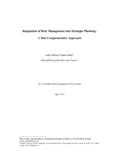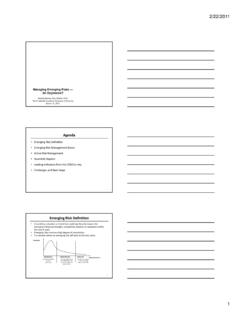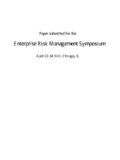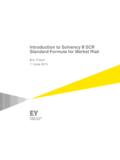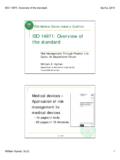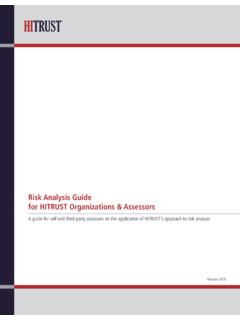Transcription of Integrated Qualitative and Quantitative Risk …
1 Paper submitted for the: Enterprise Risk Management Symposium April 22-24 2013, Chicago, IL Integrated Qualitative AND Quantitative RISK analysis OF PROJECT PORTFOLIOS Lev Virine, Intaver Institute Inc. 303, 6707, Elbow Drive , Calgary, Alberta, Canada, T2V0E5 Tel: (403)692-2252 e-mail: ABSTRACT Project portfolio risk management and risk analysis is one of the critical components of ERM. Organizations measure and analyze risks associated with projects, project portfolios, and programs. Such risks can be related to project schedules and affect project durations, completion dates, costs, resources, success rates, etc. The project risks can be also non related to particular project schedules and affecting market, capital, insurance, joint ventures, and other parameters.
2 The process of project portfolio risk management is started with risk identification. risks are included to the corporate risk register and presented on the risk matrix. At this step risk probabilities and impacts are defined qualitatively. The second step of the process is Quantitative risk analysis of project schedules using Event Chain Methodology (ECM). ECM is a stochastic modeling technique for schedule risk analysis . All risks , including schedule and non-schedule related risks are assigned to a particular project and within this project to the particular activity or resource. Further, ECM allows to model relationship between project risks by defining risks , which cause or trigger other risks . All risks and relationship between them will be presented on the project or portfolio Gantt charts using Event Chain Diagrams.
3 After risks are assigned to project and portfolio schedule, Monte Carlo simulation of project schedule is performed based on standard scheduling algorithm. Statistical distributions of project cost, duration, finish time, resource allocation and other parameters help to determine the chance that the project can be completed on time and on budget. Risk impact is calculated based on correlation between incremental increase of task s cost or duration and project cost, duration, and other parameters. risks within a risk register are ranked based on calculated impact and probabilities. The methodology simplifies complex risk analysis process, which in most cases is performed by project schedulers. ENTERPRISE RISK MANAGEMENT IN PROJECT-BASED ORGANIZATIONS Many organizations especially in the construction, aerospace, pharmaceutical and other industries focus their resources primary on projects rather than on operation.
4 Project is a temporary endeavour undertaken to create a unique, product, service, or result (Project Management Institute, 2009). Projects are time-related and usually include multiple activities and resources. Many projects have a project schedule with a number of interlinked activities and resources attached to them. The projects are managed by tracking actual project performance versus original project plans. Most organizations have a portfolio of projects which can be related to each other, for example, by sharing the same resources. Project management includes project scope, time, quality, procurement, and other processes. One of the most important project management processes is risk management. Project risk management include steps of risk management planning, risk identification, Qualitative and Quantitative risk analysis , risk response planning, risk monitoring and control.
5 The main difference between enterprise risk management for operation-based organization and portfolio risk management is that in portfolio risk management many risks can be assigned to the activities of project schedules. For example, some risks can affect activity s duration, the same or other risk can affect activity s cost, resource allocation, project success rate, and other project parameters. By assigning risk to project activity and recalculating project schedule it is possible to determine how risk would affect the schedule and portfolio. Risk register in project portfolio includes schedule-related risks , and non-schedule risks . Market, capital, insurance, joint ventures belong to the category of non-schedule risks .
6 They may be assignment to activities of project schedule but they don t affect project schedule directly. risks related to activity s duration and cost are affecting project schedule. Quantitative VS. Quantitative analysis OF PROJECT PORTFOLIO Risk register of project portfolio is a set of risks of opportunities with their properties. The risk properties include: - Risk attributes, such as risk description, objectives, owner, start and end date, etc. - Risk costs - Risk mitigation and response plans - Risk reviews - Historical information about risk - Risk assignments Risk can be assigned to different projects within a portfolio and to different activities and resources within a project. When risk is assigned to different activity, it must have certain probability and impact.
7 Here is a list of typical impacts for schedule-related risks and opportunities assigned to the activities: - Cost increase of the activity - Duration increase of the activity - Relative income of the activity - Cancel or end task - Restart task For example risk Supplier did not deliver the components may affect three different activities of two project schedule within a portfolio. Since components can be different, probabilities of each risk assignment can be different as well: Probability Impact Impact Value Activity 1 10% Restart Task Activity 2 30% Fixed Delay 2 days 20% Fixed Cost Increase $ Activity 3 25% Relative Delay 20% of activity s duration 30% Reduce Quality Reduce quality of a non-schedule risk impact.
8 Other impacts are schedule-related. The risk assigned to resources may include increase of hourly rate, re-assigning resource to different activities and others. Risk and opportunity and can be converted to issue, the issue can be converted to lesson s learned. Risk and opportunities can be presented on risk probability vs. impact matrix. The risks can be ranked based on risk score, which is risk probability multiplied on risk impact. Standard non-schedule risk categories for project portfolio include quality, technology, safety, security, public relations, and other. All schedule-related risks affecting project scope, duration, and cost belong to one category. Schedule-related project parameters are Integrated with each other.
9 For example, if duration increases, it will lead to increase of project cost. analysis of project portfolio can be performed qualitatively by assigning risk probability and impacts to different risks . However for schedule related risks , calculation of risk impact using Qualitative analysis only can be very challenging. Particularly, one risk can be assigned to different projects and activities. Cumulative impact of such risk is difficult to calculate without Quantitative analysis . Also if risk is assigned to the activity which is not on the critical path, risk impact on total project can be zero even risk impact on the particular activity can be very significant. Therefore the process of portfolio risk analysis should include both Qualitative and Quantitative analysis .
10 The Quantitative analysis can be performed using Event Chain Methodology (ECM). BASICS TO EVENT CHAIN METHODOLOGY risks from the corporate risk register may be assigned to different project activities with different probabilities and impacts. In addition to it each risk may have multiple mitigation plans, which can be different for each activity. Risk register, project schedule, and a set of mitigation plans is essentially a probabilistic project model. Since number of activities can be very significant, the overall project model can be quite complex. Event chain methodology is design to simplify the risk analysis process for the project schedules. Here are some motivations behind developing Event chain methodology: 1.
